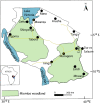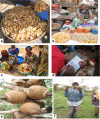Wild mushroom--an underutilized healthy food resource and income generator: experience from Tanzania rural areas
- PMID: 23841964
- PMCID: PMC3745650
- DOI: 10.1186/1746-4269-9-49
Wild mushroom--an underutilized healthy food resource and income generator: experience from Tanzania rural areas
Abstract
Background: This study documents the use of a wild edible mushroom (WEM) in Tanzania rural areas and assesses its significance as a source of healthy food and income for the disadvantaged rural dwellers.
Methodology: The data was gathered through local market surveys in order to conventionally identify different common WEM taxa using a semi-structured interview and it involved 160 people comprised of WEM hunters, traders and consumers. The collected data covered the information on where, how, when and who was the principal transmitter of the mycological knowledge learned and the general information on their market and values.
Results: Results show that mushroom gathering is gender oriented, dominated by women (76.25%) whereas men account for 23.75%. Women possess vast knowledge of mushroom folk taxonomy, biology and ecology and are therefore the principal knowledge transmitters. It was also found that learning about WEM began at an early age and is family tradition based. The knowledge is acquired and imparted by practices and is mostly transmitted vertically through family dissemination. The results also revealed that 75 WEM species belong to 14 families sold in fresh or dry form. The common sold species belonged to the family Cantharellaceae (19) followed by Rusullaceae (16) and Lyophyllaceae (13), respectively. Collectors residing near miombo woodland may harvest 20-30 buckets (capacity 20 liters) and the business may earn a person about $400-900 annually.
Conclusion: This finding envisages the purposeful strengthening of WEM exploitation, which would contribute significantly in boosting the rural income/economy and reduce conflicts between community and forest conservers. The activity would also provide alternative employment, improve food security to rural disadvantaged groups especially women and old people hence improve their livelihood.
Figures




Similar articles
-
Ethnomycological study of edible and medicinal mushrooms in Menge District, Asossa Zone, Benshangul Gumuz Region, Ethiopia.J Ethnobiol Ethnomed. 2020 Mar 4;16(1):11. doi: 10.1186/s13002-020-00361-9. J Ethnobiol Ethnomed. 2020. PMID: 32131860 Free PMC article.
-
Diversity and ethnomycological importance of mushrooms from Western Himalayas, Kashmir.J Ethnobiol Ethnomed. 2022 Apr 13;18(1):32. doi: 10.1186/s13002-022-00527-7. J Ethnobiol Ethnomed. 2022. PMID: 35418143 Free PMC article.
-
Identifying indigenous practices for cultivation of wild saprophytic mushrooms: responding to the need for sustainable utilization of natural resources.J Ethnobiol Ethnomed. 2019 Dec 12;15(1):64. doi: 10.1186/s13002-019-0342-z. J Ethnobiol Ethnomed. 2019. PMID: 31831075 Free PMC article.
-
Women care about local knowledge, experiences from ethnomycology.J Ethnobiol Ethnomed. 2012 Jul 18;8:25. doi: 10.1186/1746-4269-8-25. J Ethnobiol Ethnomed. 2012. PMID: 22809491 Free PMC article. Review.
-
Mushroom hunting and consumption in twenty-first century post-industrial Sweden.J Ethnobiol Ethnomed. 2019 Aug 19;15(1):42. doi: 10.1186/s13002-019-0318-z. J Ethnobiol Ethnomed. 2019. PMID: 31426821 Free PMC article. Review.
Cited by
-
Folk taxonomy of wild mushrooms in communities of the indigenous groups Chatino, Chontal, and Chinantec in Oaxaca, Mexico.J Ethnobiol Ethnomed. 2025 May 1;21(1):30. doi: 10.1186/s13002-025-00779-z. J Ethnobiol Ethnomed. 2025. PMID: 40312355 Free PMC article.
-
Extreme levels of mycophilia documented in Mazovia, a region of Poland.J Ethnobiol Ethnomed. 2019 Feb 12;15(1):12. doi: 10.1186/s13002-019-0291-6. J Ethnobiol Ethnomed. 2019. PMID: 30755235 Free PMC article.
-
Wild edible ectomycorrhizal fungi: an underutilized food resource from the rainforests of Tshopo province (Democratic Republic of the Congo).J Ethnobiol Ethnomed. 2020 Feb 10;16(1):8. doi: 10.1186/s13002-020-0357-5. J Ethnobiol Ethnomed. 2020. PMID: 32041671 Free PMC article.
-
Antimicrobial Potential, Identification and Phylogenetic Affiliation of Wild Mushrooms from Two Sub-Tropical Semi-Evergreen Indian Forest Ecosystems.PLoS One. 2016 Nov 30;11(11):e0166368. doi: 10.1371/journal.pone.0166368. eCollection 2016. PLoS One. 2016. PMID: 27902725 Free PMC article.
-
Uses and importance of wild fungi: traditional knowledge from the Tshopo province in the Democratic Republic of the Congo.J Ethnobiol Ethnomed. 2018 Feb 12;14(1):13. doi: 10.1186/s13002-017-0203-6. J Ethnobiol Ethnomed. 2018. PMID: 29433575 Free PMC article.
References
-
- Buyck B, Nzigidahera B. Ethnomycological notes from western Burundi. Belg J Bot. 1995;128:131–138.
-
- Pilz D, Molina R. Commercial harvests of edible mushrooms from the forests of the Pacific Northwest United States: issues, management and monitoring for sustainability. Forest Ecol Manag. 2002;155:3–16. doi: 10.1007/s12231-008-9043-6. - DOI
-
- Guissou KML, Lykke AM, Sankara P, Guinko S. Declining wild mushroom recognition and usage in Burkina Faso. Econ Bot. 2008;62:530–539. doi: 10.1007/s12231-008-9028-5. - DOI
-
- Zsigmond G. The meanings and functions of mushrooms as food in Hungarian folk tradition. Acta Ethnographica Hungarica. 2010;55:115–138. doi: 10.1556/AEthn.55.2010.1.8. - DOI
Publication types
MeSH terms
LinkOut - more resources
Full Text Sources
Other Literature Sources

